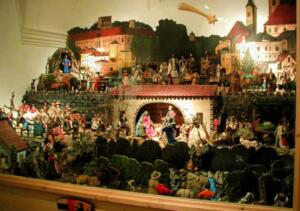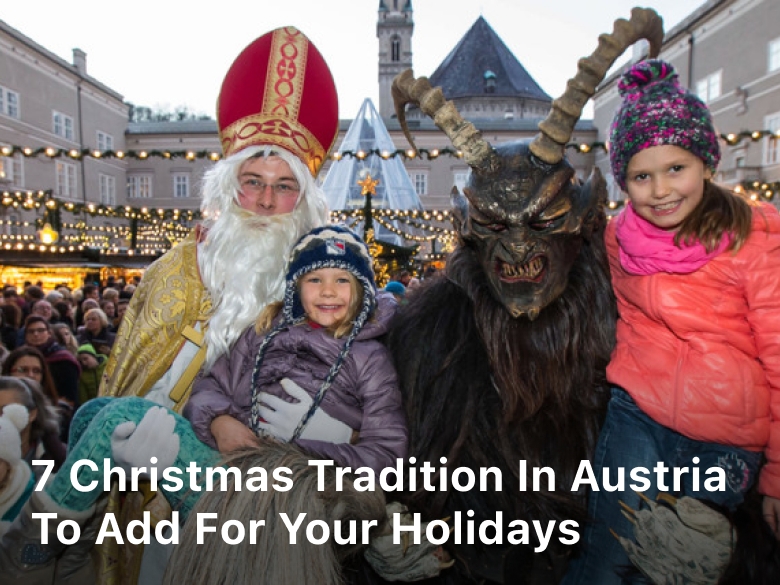roamingnomadic.com. 7 Christmas Tradition in Austria to Add for Your Holidays – Discover the enchanting 7 Christmas traditions in Austria to make your holidays truly magical. Explore unique customs, delicious treats, and festive celebrations that will warm your heart.
Austria, a land of stunning landscapes and rich cultural heritage, comes alive during the holiday season with its unique and heartwarming Christmas traditions. Whether you’re planning a visit or simply want to infuse some Austrian charm into your own celebrations, here are 7 Christmas traditions in Austria that you should consider adopting for your holidays.
As the holiday season draws near, people around the world are getting into the festive spirit. While some traditions are shared across countries, others are unique to specific regions.
Austria is a country rich in history and culture, and its Christmas traditions are no exception. From Advent wreaths and Krampusnacht to Christkindlmarkts and candle-carving, Austrian Christmas traditions are as varied as they are enchanting.
7 Christmas Tradition in Austria
Key Takeaways
- Christmas traditions in Austria are unique and enchanting.
- Austria has a rich cultural history and this is reflected in their Christmas traditions.
- From Advent wreaths and Krampusnacht to Christkindlmarkts and candle-carving, there are many fascinating Christmas traditions in Austria to discover.
Advent Wreaths and Calendars
One of the most beloved traditional Christmas traditions in Austria is the use of Advent wreaths and calendars. These festive decorations are used to count down the four weeks leading up to Christmas, and are an important part of the holiday season.
The Advent wreath is typically a circular wreath made from evergreen branches, decorated with ribbons and four candles. Each Sunday leading up to Christmas, one candle is lit to symbolize the passing of another week. On the final Sunday before Christmas, all four candles are lit, signifying the arrival of the holiday.
The Advent calendar, on the other hand, is a way to count down each day leading up to Christmas. These calendars can come in many forms, from simple paper calendars with small doors to open each day, to more elaborate designs with small gifts or chocolates behind each door. They are a favorite among children, who anxiously await each day to see what surprise will be revealed.
Advent Wreaths and Calendars in Austrian Culture
Advent wreaths and calendars have been a part of Austrian Christmas traditions since the early 19th century. Today, they can be found in homes, churches, and other public places throughout the country.
Many cities and towns in Austria also hold Advent markets, where visitors can purchase handcrafted Advent wreaths and calendars, as well as other holiday decorations and gifts.
Whether it’s lighting a candle on the Advent wreath or opening a door on the Advent calendar, the use of these traditional decorations helps build excitement and anticipation for the upcoming Christmas holiday. It’s a wonderful way to celebrate the season and connect with Austrian culture.
Krampusnacht
One of the most unique Christmas traditions in Austria is Krampusnacht or krampus. This tradition takes place on the evening of December 5th, the night before St. Nicholas Day.
Krampus is a mythical creature who is said to punish children who misbehave during the holiday season. On Krampusnacht, people dressed as Krampus roam the streets, scaring children and adults alike with their horns, fur, and chains.
While the idea of Krampus may seem frightening to some, it is actually a lighthearted and enjoyable tradition for many Austrians. It is a reminder to children to behave well during the holiday season and a way for adults to have some fun and get into the Christmas spirit.
The Legend of Krampus
The legend of Krampus dates back to pre-Christian times and is believed to have originated in the Alpine region of Europe, including Austria. According to the legend, Krampus is the opposite of St. Nicholas. While St. Nicholas rewards children who are good, Krampus punishes those who are naughty.
Krampus is often depicted as a hairy, demonic creature with horns, fangs, and a long forked tongue. He carries a basket or a sack on his back, into which he puts naughty children to take them away.
Krampusnacht Celebrations
In Austria, Krampusnacht is celebrated in many different ways. Some towns hold Krampus parades, where people dressed as Krampus march through the streets while spectators watch from the sidelines. Others have Krampus balls, where people dress up in elaborate costumes and dance the night away.
In some villages, Krampus will visit homes to scare the children into being good. Parents may even hire a Krampus to visit their children to encourage them to behave during the holiday season.
While Krampusnacht may seem like a dark and scary tradition, it is an important part of Austrian culture and is enjoyed by many during the Christmas season.
Christkindlmarkts
Christkindlmarkts are an integral part of the Christmas traditions in Austria, dating back to the Middle Ages. These markets are held in towns and cities throughout the country and are known for their festive atmosphere and traditional items.
The history behind Christkindlmarkts is rooted in the idea of celebrating the birth of Jesus and sharing joy and happiness with others. The markets are typically held in the main square of the town or city and feature vendors selling a variety of goods such as handmade crafts, ornaments, and traditional holiday treats.

Visitors to Christkindlmarkts can also enjoy live music performances, puppet shows, and other forms of entertainment. The markets are often decorated with twinkling lights and festive decor, creating a magical and enchanting atmosphere.
Traditional Items Found in Christkindlmarkts
One of the main attractions of Christkindlmarkts is the selection of traditional items available for purchase. Some of the most popular items include:
- Lebkuchen: These gingerbread cookies are a staple of Austrian Christmas cuisine and are often shaped like hearts or other festive shapes.
- Glühwein: This hot mulled wine is a popular drink at Christkindlmarkts and is served in decorative mugs.
- Handmade Ornaments: Visitors can find a variety of handmade ornaments, including wooden figurines, glass-blown baubles, and ceramic pieces.
- Candles: Intricate and beautifully decorated candles are also available for purchase, often featuring holiday motifs such as snowflakes and angels.
Attending a Christkindlmarkt is a must-do experience for anyone looking to get into the holiday spirit and immerse themselves in Austrian Christmas traditions.
St. Nicholas Day
St. Nicholas Day is a beloved tradition in Austria, celebrated on the 6th of December. This day commemorates St. Nicholas, the patron saint of children and the precursor to Santa Claus. On this day, children place their freshly polished boots outside their doors, hoping they will be filled with treats and gifts from St. Nicholas.
St. Nicholas is often accompanied by Krampus, a mythical creature who punishes children who have been naughty. In some parts of Austria, Krampusnacht (Krampus Night) is celebrated the night before St. Nicholas Day. During this event, men dress up as Krampus and roam the streets, frightening children who have behaved badly during the year.
Advent Concerts and Choirs
Austria is renowned for its musical heritage, and during the festive season, there are few better ways to experience this than through advent concerts and choirs. These musical performances play a crucial role in Austrian Christmas traditions, offering a unique way to celebrate the holiday season.
History of Advent Concerts and Choirs
The tradition of advent concerts and choirs dates back centuries in Austria. Music has always played a pivotal role in the country’s cultural heritage, and the festive season provides the perfect opportunity for musicians and singers to showcase their talents.
In particular, choirs have been an integral part of Austrian Christmas celebrations since the Middle Ages, with many churches and communities hosting their own performances.
Importance of Advent Concerts and Choirs
Advent concerts and choirs are an essential part of Austrian Christmas traditions, providing the chance to come together as a community and celebrate the season.
These musical performances offer a sense of closeness and warmth, bringing people together in joyous song and spreading the festive spirit throughout the country. They also offer a unique opportunity to experience Austria’s musical heritage and witness the incredible talent of local musicians and singers.
Where to Experience Advent Concerts and Choirs
There are numerous opportunities to experience advent concerts and choirs throughout Austria during the Christmas season. Many churches hold their own performances, providing a traditional and authentic way to enjoy the festive music.
Alternatively, there are many concerts and performances held in concert halls and public spaces, often featuring larger choirs and musical ensembles. Visitors to Austria during the festive season should be sure to check their local listings to find out about upcoming performances.
Overall, advent concerts and choirs are a must-see part of Austrian Christmas traditions. Through this musical heritage, visitors can experience the warmth and joy of the festive season and gain a deeper appreciation for the unique culture of Austria.
Candle-Carving
One of the most beautiful and unique Christmas traditions in Austria is candle-carving. This traditional Christmas tradition in Austria involves carving intricate designs into candles to create stunning decorative pieces.
Candle-carving is a beloved Austrian tradition that began in the early 1900s, and it continues to be a popular activity during the holiday season. Typically, the candles used for carving are white or ivory, and they are made from beeswax or paraffin.
The candle-carving process begins with outlining the design on the candle with a pencil or stylus. Then, a special carving knife is used to carefully remove the wax around the design. This creates a three-dimensional effect that makes the design come alive when the candle is lit.
Candle-carving designs can range from simple shapes and patterns to incredibly intricate scenes, such as a nativity or a winter forest. Some candles are even carved to depict traditional Austrian folktales.
Candle-carving is a beautiful way to add a unique touch to your holiday decorations, and it’s a fun activity to do with family and friends. You can find candle-carving kits at many Christmas markets in Austria, or you can try your hand at it with a basic carving kit from a craft store.
Nativity Scenes
One of the most beloved Christmas traditions in Austria is the display of nativity scenes, known as Krippe. These scenes often feature intricate and detailed figurines of the Holy Family, angels, shepherds, and farm animals. The tradition of creating and displaying nativity scenes dates back to the 16th century when a priest from Bavaria brought a nativity scene to his church in Salzburg.
Today, you can find nativity scenes throughout Austria, from homes and churches to public squares and museums. Some of the most elaborate Krippen can be found in the villages of Tirol, where entire rooms are decorated with life-sized figures and miniature villages.
Types of Nativity Scenes
There are several types of nativity scenes found in Austria:
| Type | Description |
|---|---|
| Salzburg-style | Features Baroque-style figurines and elaborate decorations |
| Tirol-style | Includes detailed landscapes and hand-carved wooden figurines |
| Oberammergau-style | Hails from the Bavarian village of Oberammergau and is known for its intricate wood carvings |
Many families also have their own nativity scenes at home, often passed down through generations and cherished as a family heirloom.
Overall, the display of nativity scenes is a beloved tradition in Austria and serves as a beautiful reminder of the true meaning of Christmas.
Christmas Eve Traditions
Christmas Eve is a special time in Austria, filled with unique and cherished traditions. Many Austrians attend midnight Mass, known as “Christmette,” to celebrate the birth of Jesus. This is a significant event, and it’s one of the most important Christmas traditions in Austria.
Before heading to church, families often light candles on the tree, which is typically a small one called the “Christbaum,” and exchange gifts. The tradition of gift-giving on Christmas Eve is deeply rooted in Austrian culture and is a cherished custom.
Another Austrian Christmas Eve tradition is the “Weihnachtsgans,” or roasted goose, which is a staple dish served for the holiday dinner. Additionally, some families serve a special bread called “Christstollen” and a dessert known as “Weihnachtskekse,” or Christmas cookies.
After dinner and gifts, some families continue the festive atmosphere with games, singing traditional carols, and enjoying the holiday spirit. It’s a special time for Austrians to come together with loved ones and celebrate the joy of the season.
Silent Night, Holy Night
One of the most well-known Christmas carols in the world, “Silent Night” has its roots in Austria. The song was written in 1818 by Joseph Mohr, a young priest, and Franz Gruber, a schoolteacher and church organist. Originally written in German and called “Stille Nacht, Heilige Nacht,” the song was first performed on Christmas Eve in the village of Oberndorf, Austria.
The touching lyrics and simple melody of “Silent Night” quickly captured the hearts of people around the world. Today, the song has been translated into over 300 languages and is a beloved part of many Christmas celebrations.
The Significance of “Silent Night” in Austrian Christmas Traditions
“Silent Night” holds a special place in Austrian Christmas traditions. Every year on December 24th, the song is played in churches and homes throughout the country, often as part of a midnight Mass. The gentle melody and peaceful lyrics serve as a reminder of the true meaning of Christmas and the importance of love and compassion.
In addition to being a cherished part of Austrian Christmas celebrations, “Silent Night” is also an important symbol of peace and unity around the world. In 2011, UNESCO declared the song to be part of Austria’s cultural heritage and added it to the Representative List of the Intangible Cultural Heritage of Humanity.
Whether sung in German or another language, “Silent Night” remains a beautiful expression of the joy and wonder of Christmas.
Christmas Cuisine in Austria
Austrian Christmas cuisine is a delightful blend of sweet and savory flavors that will tantalize your taste buds. Traditional dishes are a key part of the Christmas celebrations in Austria, and they are often passed down through generations.
Roasted goose, served with red cabbage and bread dumplings, is a classic Christmas Eve dish in Austria. It is a rich and succulent meal that symbolizes the abundance of the holiday season.
Gingerbread cookies, or Lebkuchen, are a traditional Christmas treat in Austria. These honey-spice cookies, often shaped like hearts or stars, are deliciously soft and chewy, and they make the perfect accompaniment to a warm cup of tea or coffee.
Gluhwein, or mulled wine, is a hot spiced wine that is a staple at Christkindlmarkts, or Christmas markets, across Austria. The sweet and spicy drink is a great way to keep warm on a chilly winter day as you explore the market stalls.
Another festive drink is Eierlikor, a creamy egg liqueur that is typically consumed after the Christmas Eve feast.
Marzipan, a sweet almond paste, is a popular ingredient in Austrian Christmas desserts, including Stollen, a rich fruitcake filled with marzipan and dusted with powdered sugar.
Overall, Austrian Christmas cuisine is the perfect complement to the enchanting Christmas traditions in Austria, and a must-try for any foodie visiting during the holiday season.
Keep Reading : 9 Traditional Christmas Foods in Austria You Should Try
Conclusion
As the holiday season approaches, exploring Christmas traditions in Austria is an enchanting way to get into the spirit of the festivities. From Advent wreaths and calendars to the unique Krampusnacht tradition, there is something for everyone to experience.
The Christkindlmarkts, or Christmas markets, provide a wonderful opportunity to shop for traditional gifts and indulge in the delicious cuisine of the season, such as roasted goose and gingerbread.
Music is also an essential part of the Austrian Christmas experience, with Advent concerts and choirs adding to the festive atmosphere. Candle-carving and nativity scenes are also important and beautiful parts of the celebrations.
On Christmas Eve, the lighting of candles and attending midnight Mass are just a few of the special traditions that take place. And of course, no discussion of Christmas in Austria would be complete without mentioning the beloved carol “Silent Night.”
Whatever your interests may be, there is no denying the magic of experiencing Christmas traditions in Austria firsthand. So this holiday season, consider adding some Austrian flair to your celebrations and create memories that will last a lifetime.
Keep Reading : Best Winter Destinations Austria You Should Visit in 2023
FAQs
Q: What are some traditional Christmas traditions in Austria?
A: Some traditional Christmas traditions in Austria include Advent wreaths and calendars, Krampusnacht, Christkindlmarkts, St. Nicholas Day, Advent concerts and choirs, candle-carving, nativity scenes, Christmas Eve traditions, “Silent Night” carol, and Christmas cuisine.
Q: What is the significance of Advent wreaths and calendars in Austria?
A: Advent wreaths and calendars are used in Austria to count down the days until Christmas. The wreaths are typically adorned with four candles, one for each Sunday leading up to Christmas, and each candle is lit on its corresponding Sunday. Advent calendars often contain small treats or gifts behind each day’s door, providing a daily surprise during the Advent season.
Q: What is Krampusnacht?
A: Krampusnacht is a unique Austrian tradition where people dress up as Krampus, a mythical creature, to scare children into being good during the holiday season. It typically takes place on the evening of December 5th, the night before St. Nicholas Day, and involves parades and festivities.
Q: What are Christkindlmarkts?
A: Christkindlmarkts, or Christmas markets, are popular in Austria. They are festive outdoor markets where people can shop for traditional Christmas decorations, crafts, and food. These markets often have a cozy atmosphere with twinkling lights, live music, and the delicious scent of roasted chestnuts and mulled wine in the air.
Q: What is St. Nicholas Day in Austria?
A: St. Nicholas Day is a tradition in Austria where children receive treats and gifts from St. Nicholas, the precursor to Santa Claus. It is celebrated on December 6th, and children often leave their shoes out overnight to be filled with goodies by St. Nicholas.
Q: What is the significance of Advent concerts and choirs in Austria?
A: Advent concerts and choirs hold great importance in Austrian culture during the Christmas season. These musical performances help set the festive mood and create a sense of anticipation leading up to Christmas. They often feature traditional Christmas carols and hymns.
Q: What is the tradition of candle-carving in Austria?
A: Candle-carving is a unique tradition in Austria where intricate designs are carved into candles to create beautiful Christmas decorations. These carved candles are often displayed in windows and add a warm and festive touch to Austrian homes during the holiday season.
Q: How are nativity scenes significant in Austrian Christmas traditions?
A: Nativity scenes play a significant role in Austrian Christmas traditions. They are displayed in homes, churches, and public spaces, representing the birth of Jesus. Many Austrians take pride in creating elaborate and detailed nativity scenes, often using handcrafted figurines.
Q: What are some Christmas Eve traditions in Austria?
A: Christmas Eve in Austria is filled with unique traditions and customs. Families typically light candles on the Christmas tree and exchange gifts. Many Austrians also attend midnight Mass to celebrate the birth of Jesus and enjoy a festive meal with loved ones.
Q: What is the significance of the carol “Silent Night” in Austrian Christmas traditions?
A: The beloved Christmas carol “Silent Night” has its origins in Austria. It was composed in 1818 in the village of Oberndorf and holds great significance in Austrian Christmas traditions. The carol is often sung during Advent concerts, Christmas Eve services, and family celebrations.
Q: What are some traditional Austrian Christmas dishes?
A: Traditional Austrian Christmas cuisine includes dishes like roasted goose, gingerbread, and Glühwein, which is mulled wine. These delicious treats are enjoyed by families and visitors during the holiday season in Austria.





